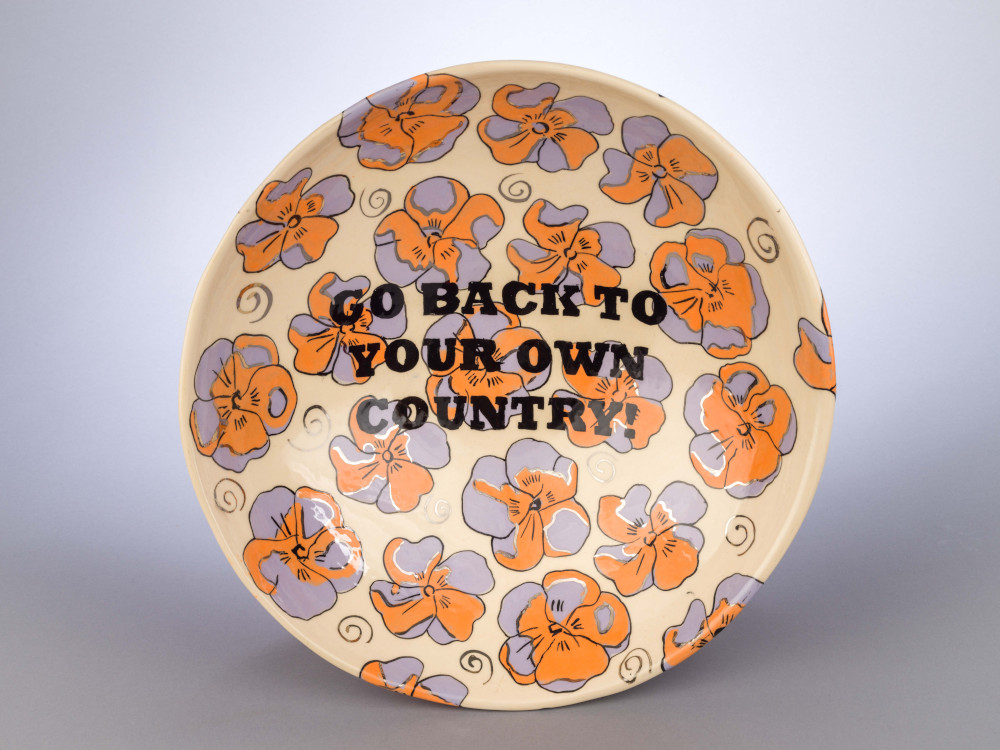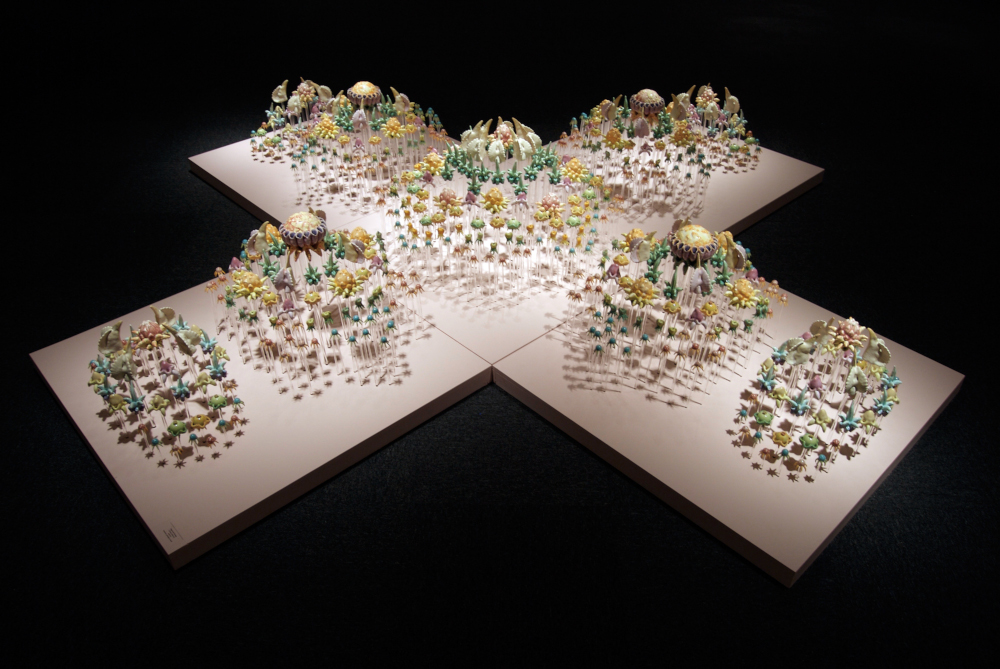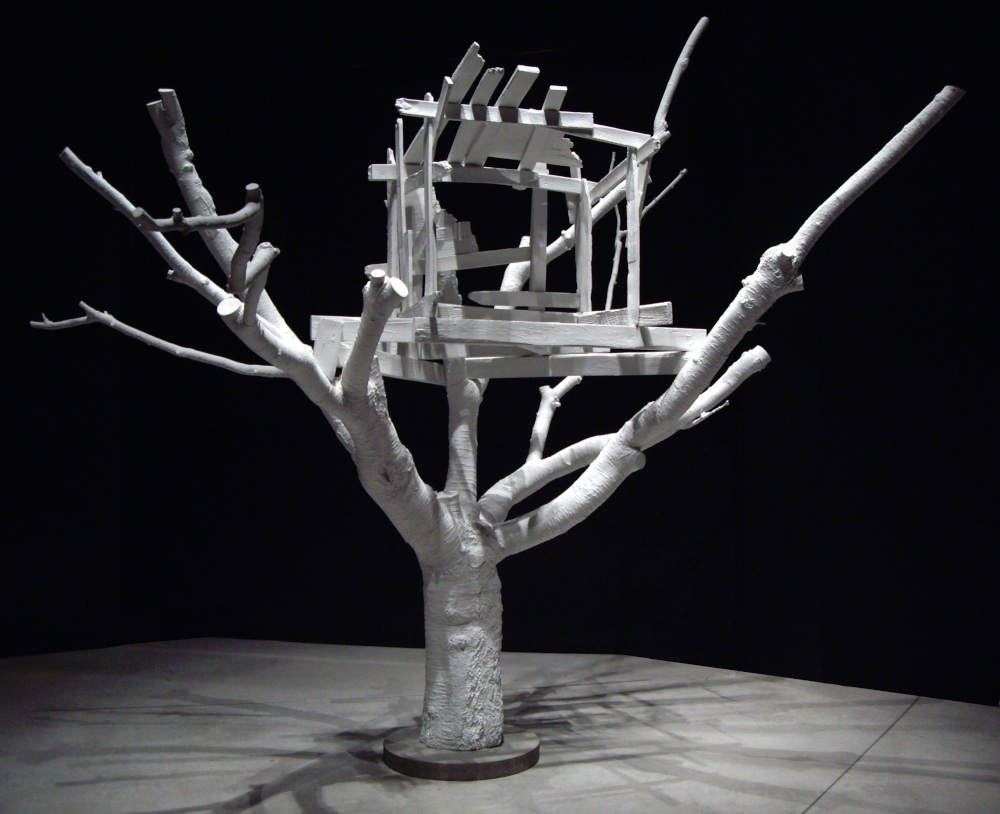Clay is biblical stuff. God scooped up a handful and fashioned people, and humans repaid the favour by turning clay into all kinds of things: cups, bowls, plates — and art.
Playing with Fire: Ceramics of the Extraordinary is a new exhibition at UBC’s Museum of Anthropology that explores the many things this most prosaic of materials can become. Politics, memory, loneliness, and the occasional good old-fashioned phallus are only a few of the ideas on offer in Playing with Fire.
As the show’s curator Carol E. Mayer explains, the title is a play on both the process of transforming the raw material as well as the dangers inherent therein. Things occasionally blow up during the clay firing process.
In putting the show together, she says she was inspired by artist Gathie Falk’s statement about taking the ordinary and transforming it into something extraordinary.
The idea applies to the show in its entirety, beginning with the subtle entrance. The door to the gallery is graced by two pairs of shoes — sneakers and baby boots thrown over a wire, not unlike what you might find in any urban back alley. Is it a gang sign, homage to an urban myth, or murder site — all rendered in bone-white porcelain?
Artist Jeremy Hatch’s work takes ordinary objects and transforms them into ghost versions of themselves. The shoes are intriguing and deeply mysterious, but another of Hatch’s pieces ups the ante considerably as the artist recasts an entire cherry tree, complete with a child’s treehouse, in glimmering frosty porcelain. The effect is curious, a kind of push-and-pull between nostalgia and corporeal reality; like the past, it’s both there and not there. You want to touch it, but you know you can’t.
(As if reiterating the point, while at MOA I craned my head too close to the work and set off the alarm sensor.)
As we walk through the exhibition Mayer tells me about the 11 different artists and their work. Most are from British Columbia, a few from more far-flung locales, such as Taiwan, but the uniting element is the wildly inventive purposes to which they put clay.
Turns out that politics mixes easily with porcelain.
Nowhere is this idea more powerfully apparent than in the work of Cree artist Judy Chartrand. Chartrand takes on racism, poverty and violence and casts them in sculpture installations that mix pain and humour. The combination has the effect of sharpening the edges of her work.

A stunning example is If This Is What You Call ‘Being Civilized’, I’d Rather Go Back to Being a ‘Savage’, featuring a series of elegant bowls emblazoned with a wad of cheerful cockroaches.
Vancouver’s SRO hotels, missing and murdered Indigenous women and a casually racist encounter between two motorists on a city street all feature in Chartrand’s work.
But it’s her recreation of a lunch counter in Counteract that coldcocks you. All of the traditional trappings of a classic diner — ketchup, menu, napkins, stools — are cast in blinding white. Just behind the counter is a rogue’s gallery of racist toys, memorabilia and novelty items.
Gollywogs, Chinese laundry workers and other items collected over the years by Chartrand have been fashioned anew. In Chartrand’s work, these caricatures of race, made by white people, are stripped of their camouflage as “humour” and revealed for what they truly are.

While studying at the Nova Scotia College of Art and Design in Halifax, Ying-Yueh Chuang was so lonely she created an army of objects resembling so many anthropomorphic lollypops. Arranged in a t-shape, this delectable garden of water-colour-hued curiosities cast delicate shadows. Whether you see flowers, squid or odd anime characters, the shapes move as you walk around the installation, emblematic of the artist’s hybrid existence and identity.
This same quality of transformation, moving from one state to another — hard into soft, rough into smooth, blank into pattern — reaches an epic apotheosis in the Brendan Tang’s work. Tang, who teaches ceramics at Emily Carr, combines anime and manga influences with traditional blue-and-white Chinese pottery to create car-crash mashups. Like creatures caught in mid-transmogrification, the work is funny, strange, beautiful and unsettling all at the same time.
Clay can be an unpredictable medium, as artist Glenn Lewis can attest. Lewis was commissioned to create a wall-sized installation for the Canada Pavilion for the 1970 World Fair in Osaka, Japan. But when the work arrived, organizers took one look and said, Nope! It’s not hard to see why. Artifact is, well, kinda happy to see you!
Although Lewis maintained that the shapes jutting off the wall were based on salt-and-pepper shakers, they resemble so many jaunty phalluses. Mayer says the work was displayed only a couple of times, at the Vancouver Art Gallery for example, but here it is at MOA in all its glory.
The 176 tiles contain all variation of protuberances, a few broken off and many more aiming towards the sky, as well as calendar entries on what the artist was up to on that particular day. Overtop the work is an additional layer of meaning — censorship, prurience and creative intent thwarted. After getting stiffed (heh) by the federal government, Lewis was forced to buy back his own work.
There’s something about the tactility and three-dimensionality of ceramics that leaps lightly past the intellect and heads straight for the gut. This quality is especially apparent in Bill Rennie’s replica of his former house and property in Surrey. At first glance, the work looks like a miniature movie set, complete with exquisite replicas of tiny cedar trees, minute rows of corn and a slough just behind the house itself.
The work is an act of memento mori; the trees, the house and the little pond are all gone. Rennie’s former home is now covered by 12 different houses. Displacement, urbanization and loss are all there, embodied in perfect lilliputian form, both sweet and deeply sad.
Clay, the most ordinary of material, also becomes Alwyn O’Brien’s terrifying filigreed towers, Gathie Falk’s iconic black boots, and Ian Johnston’s recreations of lightbulbs and old-fashioned rotary phones arranged in ordered panels, as well as Debra Sloan’s anatomically correct baby dolls that pop up amongst MOA’s permanent collection, like naughty children.
Scattered across the Koerner Ceramics Gallery, they upend conventional narratives and refashion art history like capricious, cute little gremlins.
Playing with Fire is a glorious, gorgeous and occasionally deeply emotional display of clay and all that it’s capable of becoming. Get in there and muck about. ![]()
Read more: Media
















Tyee Commenting Guidelines
Comments that violate guidelines risk being deleted, and violations may result in a temporary or permanent user ban. Maintain the spirit of good conversation to stay in the discussion.
*Please note The Tyee is not a forum for spreading misinformation about COVID-19, denying its existence or minimizing its risk to public health.
Do:
Do not: